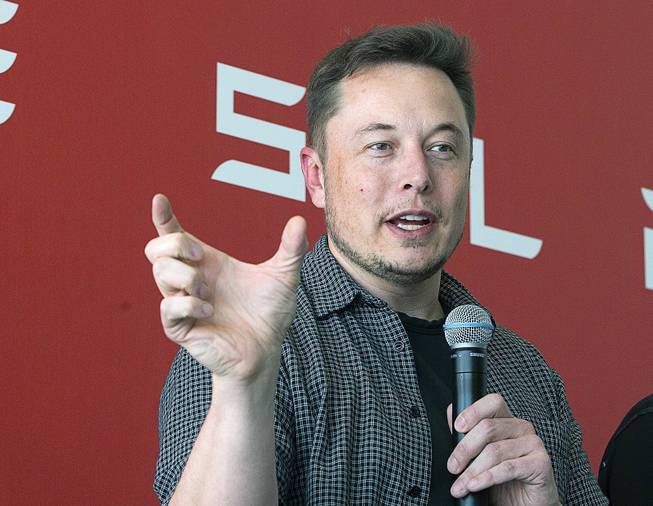
Rich Pedroncelli / AP
Tesla CEO Elon Musk discusses the company’s new Gigafactory Tuesday, July 26, 2016, in Sparks. It’s Tesla Motors biggest bet yet: a massive, $5 billion factory in the Nevada desert that could almost double the world’s production of lithium-ion batteries by 2018.
Monday, Dec. 17, 2018 | 2 a.m.
RENO — The noise and vibration at Tesla's northern Nevada Gigafactory is a constant reminder of what company CEO Elon Musk refers to as "the machine that builds the machine."
Operating 24 hours per day, more than 7,000 workers produce enough battery packs and drive units in a week to power 5,300 Tesla Model 3 sedans.
"It is not elaborate, mahogany offices here," Chris Lister, vice president of operations for the Reno production plant told the Reno Gazette Journal. "This is where work gets done."
The newspaper got a rare glimpse inside the factory recently for a multimedia report about a business the governor's Office of Economic Development credits with increasing manufacturing employment in the Reno-Sparks area by 55 percent since 2014.
A reporter found a hive of human workers, robotic arms, conveyor lines and autonomous vehicles working to assemble battery cells for Tesla sedans and other energy products.
The company says the plant is just 30 percent of its potential size at 5.4 million square feet — roughly equivalent to 50 Home Depot stores. Already it produces more batteries than all other carmakers combined, it says.
Panasonic makes the cells, which look a little like oversized AA batteries, in one part of the factory before Tesla's human and robot workforce assemble them to be used in cars and batteries that power homes and businesses.
The plant performs three major functions: battery cell manufacturing, battery pack assembly and drive unit production.
Key components are shipped to Fremont, California, where Tesla builds the Model 3 and other vehicles.
Part of the factory operated by Panasonic Energy of North America is off-limits to photos, video and audio recording. Production areas are visible from a hallway through small windows.
Workers wear masks, protective booties, gloves and head coverings and rooms are hermetically sealed with filters to control the air quality and prevent dust or other contaminants.
"Any contamination whatsoever, we basically have to scrap the batteries," Panasonic President Allan Swan said.
Specific processes and ingredients are zealously guarded. It converts raw materials such as refined lithium and steel into the cells Tesla uses to create a Model 3 battery.
Panasonic also produces cells for Tesla's models S and X vehicles in Japan, but at nowhere near the volume that the Model 3 requires.
The company invested $1.6 billion in the $5 billion factory and is the exclusive cell provider for Tesla.
Swan said there are already 11 battery cell production lines in operation and two more under construction.
With each Model 3 battery pack requiring more than 4,000 cells, Panasonic needs to churn out more than 3 million cells daily to keep pace with Tesla's ambitious production schedule.
Tesla workers and robots receive cells via autonomous vehicles from Panasonic and assemble them into Tesla products in what Lister refers to as the "handshake" between the partners.
Using a combination of human and robot labor, Tesla assembles the cells into long rows that Lister calls "bandoliers," because of the way the cells are arranged around a cooling tube.
The tubes are manufactured on-site by the company Valeo.
Bandoliers are then grouped side-by-side into modules that go through more machines that, with help from people, use wires to bond the electrical connections.
The bonding enables cells within modules to work together as a cohesive energy bank to power a Model 3 or any of Tesla's stationary products, such as the Powerwall home battery or the Powerpack, its industrial cousin.
Tesla has deployed Powerpack stationary storage power units to disaster areas when traditional electrical service is disrupted.
Although the Gigafactory is most often described as a battery factory, it's also where Tesla produces drive units that convert electrical power from a motor into force to move the wheels of a Model 3.
All-wheel drive versions of the Model 3 require two drive units. Rear-wheel models use one.
Employee amenities include free snacks including cereal, oatmeal, pretzels, coffee, tea and other beverages; outdoor fitness programs such as running, hiking and mountain biking; and private space for breastfeeding mothers.
For transportation, the factory offers vanpools and free commuter shuttles with Wi-Fi from various locations in Reno, Sparks, Fernley and Carson City that Tesla says serve about 1,700 employees.
